Writer: Tiffany Whisner, Coles Marketing
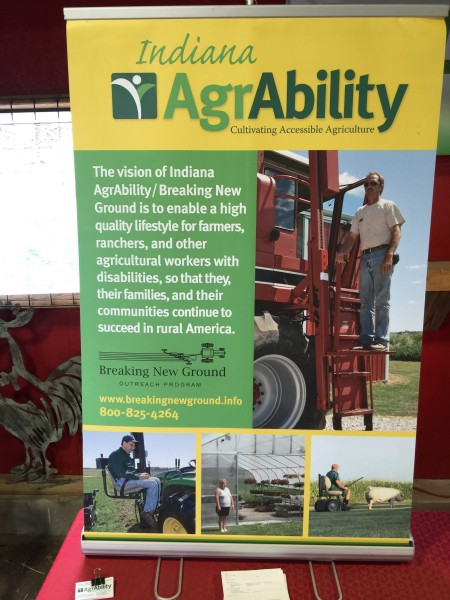 It’s officially the end of summer and the beginning of fall — a time when barbecues become roasts, and a chill in the air eventually takes over.
It’s officially the end of summer and the beginning of fall — a time when barbecues become roasts, and a chill in the air eventually takes over.
According to the Farmer’s Almanac, September 2015 brings days excellent for sowing grains, hay and forage crops. There are also good days for planting beets, carrots, Irish potatoes and other root crops. After the fields are harvested, farmers may plow them and add more fertilizer. They also start to plant crops like winter wheat.
All in a day’s work for the farmer, the rancher and other agricultural workers — even those with disabilities.
Breaking New Ground
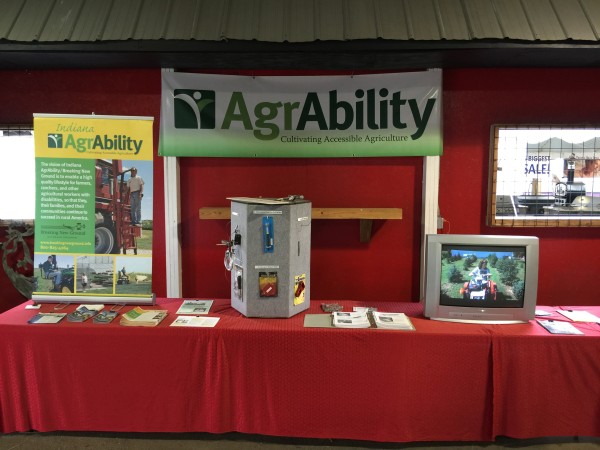 In 1979, an Indiana farmer who had been paralyzed in a pickup truck accident contacted Purdue’s Department of Agricultural and Biological Engineering for help with modifying his tractor so he could continue farming.
In 1979, an Indiana farmer who had been paralyzed in a pickup truck accident contacted Purdue’s Department of Agricultural and Biological Engineering for help with modifying his tractor so he could continue farming.
“The farmer connected with Dr. Bill Field, the extension safety specialist. That led to the establishment of the Breaking New Ground Resource Center, which provides assistance to farmers with disabilities. It was also a predecessor to the AgrAbility Project,” said Project Manager Paul Jones.
Jones holds a split appointment between the National AgrAbility Project and the Indiana AgrAbility Project. A graduate of Wabash College in economics, Jones is responsible for the day-to-day management of operations and Purdue staff as well as project coordination and the development and management of the online database of AgrAbility-related resources.
“AgrAbility was finally introduced through the 1990 Farm Bill, but the first eight state/regional AgrAbility projects weren’t funded until 1991,” Jones said. “Currently, we have 20 different programs around the country, helping agricultural workers, their families and communities continue to succeed in rural America.”
The Indiana AgrAbility Project serves farmers and other rural residents with disabilities through a collaborative effort between the USDA, the Breaking New Ground Outreach Program, and several disability- and agriculture-related organizations, such as the Arthritis Foundation-Heartland Region, Hoosier Uplands Economic Development Corporation, INDATA, the Rehabilitation Hospital of Indiana and Indiana Vocational Rehabilitation Services.
“There are state AgrAbility grants, and there is one national grant,” Jones said. “The national project supports the state projects, providing education training and resources and helping farmers in states that don’t have AgrAbility projects.”
What’s in The Toolbox?
One of the many resources on the AgrAbility website is “The Toolbox: Agricultural Tools, Equipment, Machinery and Buildings for Farmers and Ranchers with Physical Disabilities.”
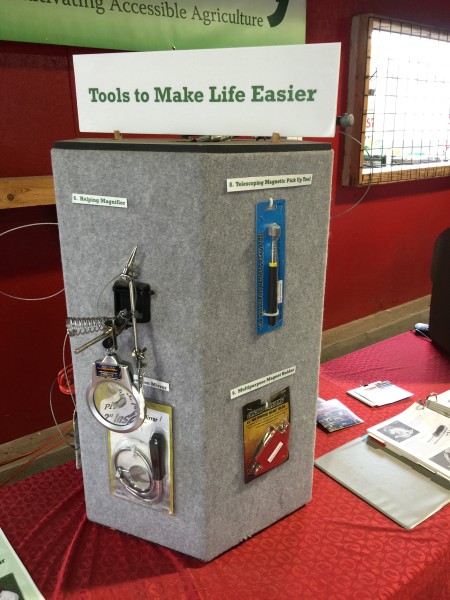 It’s a resource that contains assistive technology solutions for agricultural workers with disabilities. What can you find in this toolbox? Products, designs and ideas, techniques and suggestions and several technical reports focused on a specific topic on farming/ranching with a disability.
It’s a resource that contains assistive technology solutions for agricultural workers with disabilities. What can you find in this toolbox? Products, designs and ideas, techniques and suggestions and several technical reports focused on a specific topic on farming/ranching with a disability.
“It’s definitely the most popular thing on our website,” Jones said. “We have about 1,200 products in The Toolbox. Not all of them are specifically designed for someone with a disability, but they are all products we’ve looked at and believe someone with a limitation might be able to benefit from, making the task easier for them.”
Seven of the top 10 page visits on the AgrAbility website in the past year were for items related to The Toolbox. And for the month of May alone, there were nearly six thousand page views for the individual product pages that are part of The Toolbox.
“We get visits to this database from all over the world — Canada, Japan, China and Russia,” Jones said. “The Toolbox actually began as a paper binder, one compiled in the 80s, one in the 90s and one in 2000. Then, all the information was converted to two versions on CD, and finally we made the switch to a Web database. In comparison, we distributed around 1,000 copies of the print manuals. Having this online database makes it a lot easier to distribute all the information and make it accessible to people on a global level.”
Items in The Toolbox cover the gamut of vocations, interests and hobbies — gardening, livestock handling, outdoor recreation, safety and health, shop tools, self-propelled equipment, tractors and combines, tree fruits and nurseries, utility vehicles, crop and materials handling and many more.
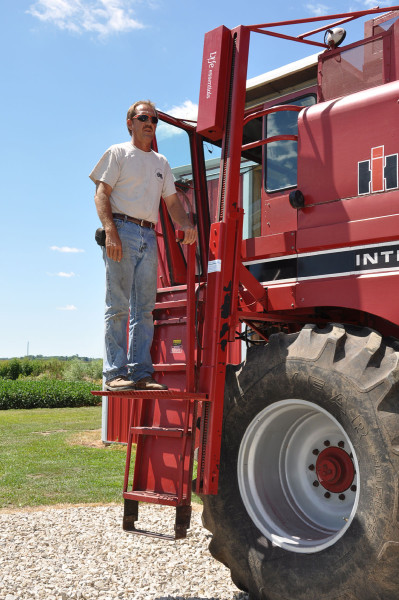 “And there are many more products in the pipeline to be added to the database,” Jones said. “We have a variety of different ways by which we add new items. We have a team that keeps their eyes open for new devices and products, and we look through a lot of farm magazines and other publications. We also get notifications from people who are manufacturing their own pieces of technology who want to make them available to others.”
“And there are many more products in the pipeline to be added to the database,” Jones said. “We have a variety of different ways by which we add new items. We have a team that keeps their eyes open for new devices and products, and we look through a lot of farm magazines and other publications. We also get notifications from people who are manufacturing their own pieces of technology who want to make them available to others.”
The AgrAbility team puts each item in The Toolbox through a review process to check for viability and for any safety concerns, and members collaborate before adding them to the database. A description is written and sent to each supplier for their comments and corrections on the entry, then the item is posted to the database and shared with the world.
Individual needs require individual support
“People working in the world of agricultural are generally very resourceful, always looking for ways to help themselves do a certain task better or more efficiently. Many may not even purchase products from The Toolbox, but they will explore and use the database as an idea stimulator. They might try to replicate it themselves — it gives them a sense of hope and purpose.”
As quoted in the article, “It’s not just that farmers are among America’s oldest workers — their average age also has been growing rapidly for about 30 years, according to the U.S. Department of Agriculture’s Census of Agriculture. This census, which is published every five years, shows that during the last 30 years, the average age of U.S. farmers has grown by nearly eight years, from 50.5 years to 58.3 years.”
“Many farmers today work well into their 80s, and we’ve even worked with some in their 90s still doing the basic day-to-day tasks,” Jones said. “There is a strong desire to not give it up. It’s their lifestyle. In this population, they’re very independent. They don’t want to admit they need help, and they are reluctant to seek out assistance.”
But as a mostly aging population, physical decline and health issues do make for limitations on the work that can be done. And the assistive technology offered through AgrAbility help not only those individuals with disabilities but also those people with functional limitations due to aging.
“Our goal is to improve their quality of life,” Jones said. “The word ‘disability’ brings to mind conditions such as amputations, spinal cord injuries and other traumatic injuries. Sometimes the biggest barrier for AgrAbility is the perception that our ser vices apply to only those individuals with specific disabilities. We also address many other conditions, like arthritis and back impairments — for those people who wouldn’t categorize themselves as having a disability.”
vices apply to only those individuals with specific disabilities. We also address many other conditions, like arthritis and back impairments — for those people who wouldn’t categorize themselves as having a disability.”
Through its partnership with the INDATA Project at Easter Seals Crossroads, AgrAbility is able to display a variety of different assistive technology tools that wouldn’t only be for someone with a disability — like a nail-starter hammer. With a grooved head and two nail-head slots, this hammer helps those with upper extremity limitations.
There are also the leaf gripper yard tongs. They allow someone to pick up gathered leaves and other debris without having to repeatedly bend down. These tools are especially beneficial for people with back impairments or age-related limitations.
“Another group we are currently working with is returning veterans,” Jones said. “We have our own veteran coordinator — she’s working with veterans who are coming back and either turning to or returning to farming.”
Last January, Purdue’s Beginning Farmer/Rancher Development Program grant began, and the AgrAbility team was pleasantly surprised at the feedback and interest in it.
“We are reaching out to veterans to help them get started in farming, or, if they have a disability, to continue on with farming. Veterans returning home may not want to work in an office,” Jones said. “Agriculture offers them a choice. It gives them a more flexible schedule, contact with nature, and other ways to help them feel productive and useful.”
But getting the word out about these additional programs and services is sometimes difficult when AgrAbility is often pigeon-holed as a farmers-only category. So they try different avenues to reach different audiences.
Increase awareness, share ideas
AgrAbility has participated at the Indiana State Fair every year for nearly 30 years, reaching out to the hundreds of thousands of fairgoers with information about their services. And the State Fair is also an example of partnership between AgrAbility and the INDATA Project.
“Wade Wingler is part of our advisory team, and we also have collaborated on some joint projects with them,” Jones said. “Wade is certainly one of our more active volunteers, and he is a great help at the Fair providing assistive technology tools to have on display from INDATA.”
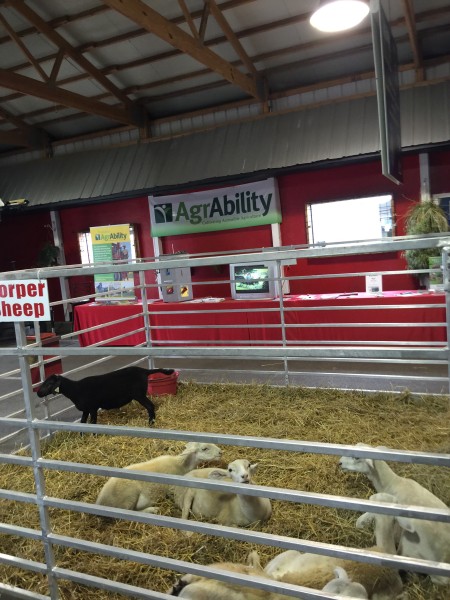 With their booth housed in the FFA Pavilion this year, AgrAbility’s goal was to increase awareness, sharing ideas and information with those who may not know what they have to offer.
With their booth housed in the FFA Pavilion this year, AgrAbility’s goal was to increase awareness, sharing ideas and information with those who may not know what they have to offer.
“Every year, we bring our demo tractor lift. We will actually ask for people to get into the equipment and have some hands-on interaction with it,” Jones said. “We use that as a draw to get people interested in what we’re doing. Then we have other tools on display, and we can answer questions about what those devices do as well.”
At the Fair and other outreach events, AgrAbility gets interest from both agricultural-specific workers as well as those with certain disabilities who are looking for support and assistance.
“We partner with Indiana’s Vocational Rehabilitation Services to get people the help they need,” Jones said. “Our AgrAbility grant doesn’t allow us to provide direct funding to these individuals, so we help them with a personal assessment on their farm or their home, and then we connect them with Voc Rehab. We determine the need and make recommendations for ways to offer support, and then we also do follow-up work to make sure everything is provided or modified in the desired way.”
As far as the assessment goes, AgrAbility staff members will go to the individual’s home or farm and see what kinds of tasks need to be done and what impairments or barriers there are for the person being able to perform needed tasks.
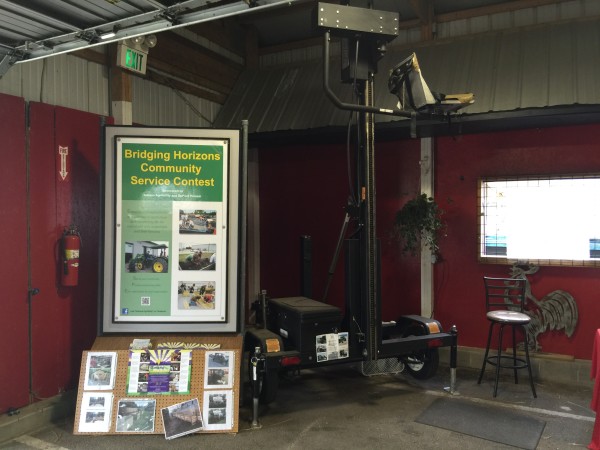 One example is an individual might have difficulty climbing due to a mobility or hand impairment, and they need to get grain into their bins. There are devices to help with that. Or another person may have trouble getting around their farm or their house due to severe arthritis.
One example is an individual might have difficulty climbing due to a mobility or hand impairment, and they need to get grain into their bins. There are devices to help with that. Or another person may have trouble getting around their farm or their house due to severe arthritis.
The AgrAbility team members are experts on what products and devices are available to help, and they are able to recommend those technologies, and Vocational Rehabilitation Services can supply the funding.
“One pilot project we’re going to try next year is a crowdfunding initiative, giving people the opportunity to submit videos of items they need or limitations they have and what we can do to help them,” Jones said. “Who knows what the results will be, but it may be an option for funding that doesn’t require Voc Rehab.”
Cultivating independence for all
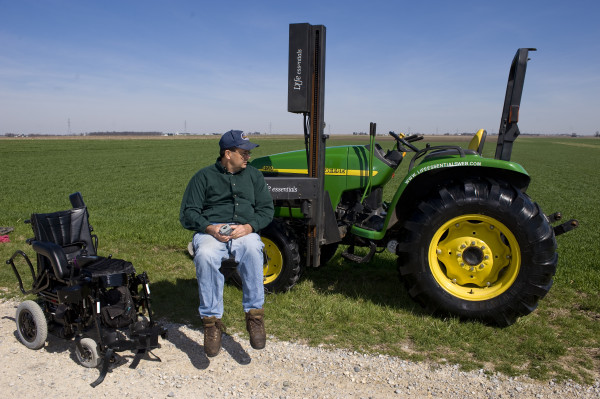 “Hope is a big issue,” Jones said. “Some of these people have been active all their lives. Then they experience a traumatic injury and could be at a total loss for what to do with their lives. They lose any hope of being productive, and that’s where AgrAbility comes in.”
“Hope is a big issue,” Jones said. “Some of these people have been active all their lives. Then they experience a traumatic injury and could be at a total loss for what to do with their lives. They lose any hope of being productive, and that’s where AgrAbility comes in.”
Jones had an initial interview with a man at the Rehabilitation Hospital of Indiana who had fallen and landed on his head, causing a brain injury. He had no idea he could continue on and didn’t imagine being able to return to his line of agricultural work.
“An assistive technology company called Life Essentials made an appointment to show him some farming equipment, and he had told his wife to forget about him ever being able to farm again. He didn’t want the help and didn’t want them on his property.” Then they got him on a combine with an accessibility lift.
“He was so excited that he drove the combine down the road to show his mom. After that, he visited the manufacturer the following week and purchased the lift on his own. It can change someone’s perspective on what they can do. It really makes them believe they can continue to do what they love in their lives.”
From arthritis to traumatic injuries, AgrAbility continues to strive to let people know there is help.
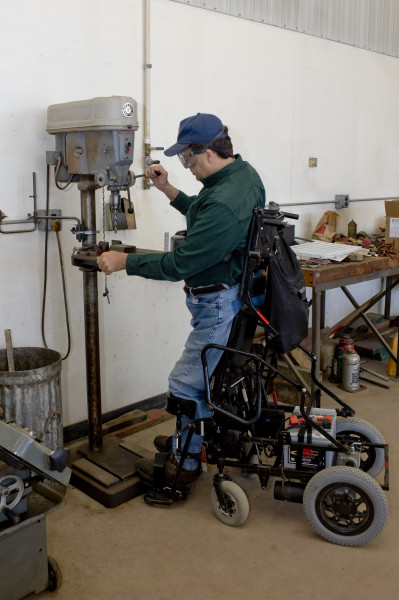 “Agriculture is a continuum — standard crop farmers, hydroponics, raising flowers — AgrAbility can help in all those situations,” Jones said. “It’s hard to encapsulate everyone, and the challenge is agriculture is so physically demanding. But there are a number of devices and services we have available — and we make each connection and assessment a personalized one.”
“Agriculture is a continuum — standard crop farmers, hydroponics, raising flowers — AgrAbility can help in all those situations,” Jones said. “It’s hard to encapsulate everyone, and the challenge is agriculture is so physically demanding. But there are a number of devices and services we have available — and we make each connection and assessment a personalized one.”
And as AgrAbility nears its 25th anniversary, they will continue to look for new ways to “break new ground.”

Along with making agriculture accessible, what we need to do is making agriculture scalable. Make farmers aware of global trade enabling platforms and other software that can help them scaling their business themselves.